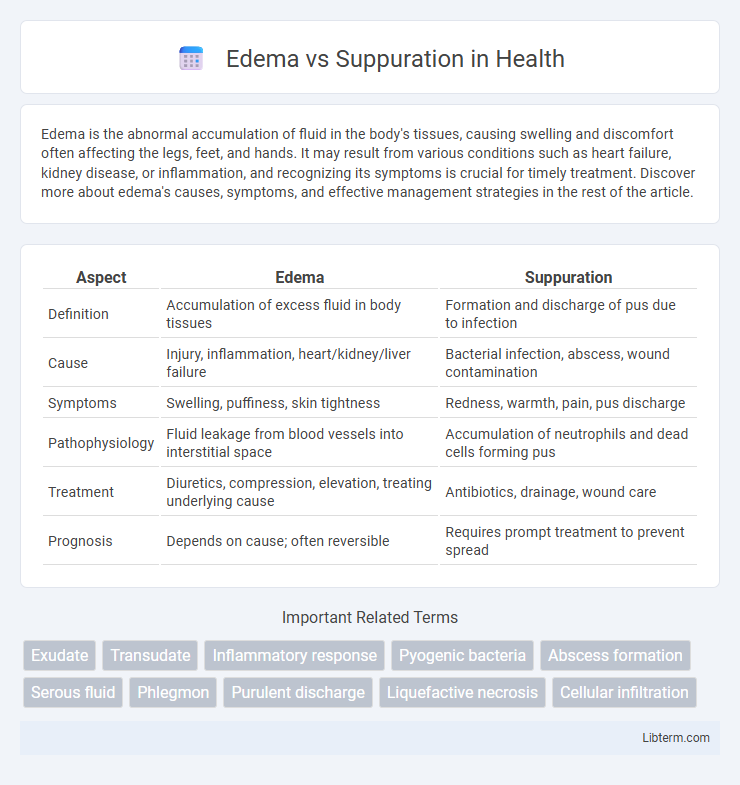Edema is the abnormal accumulation of fluid in the body's tissues, causing swelling and discomfort often affecting the legs, feet, and hands. It may result from various conditions such as heart failure, kidney disease, or inflammation, and recognizing its symptoms is crucial for timely treatment. Discover more about edema's causes, symptoms, and effective management strategies in the rest of the article.
Table of Comparison
| Aspect | Edema | Suppuration |
|---|---|---|
| Definition | Accumulation of excess fluid in body tissues | Formation and discharge of pus due to infection |
| Cause | Injury, inflammation, heart/kidney/liver failure | Bacterial infection, abscess, wound contamination |
| Symptoms | Swelling, puffiness, skin tightness | Redness, warmth, pain, pus discharge |
| Pathophysiology | Fluid leakage from blood vessels into interstitial space | Accumulation of neutrophils and dead cells forming pus |
| Treatment | Diuretics, compression, elevation, treating underlying cause | Antibiotics, drainage, wound care |
| Prognosis | Depends on cause; often reversible | Requires prompt treatment to prevent spread |
Introduction to Edema and Suppuration
Edema is characterized by the abnormal accumulation of fluid in interstitial spaces, leading to tissue swelling often caused by inflammation, injury, or circulatory problems. Suppuration refers to the process of pus formation, which occurs when the body responds to infection by accumulating dead leukocytes, bacteria, and tissue debris. Both conditions represent key pathological responses, with edema indicating fluid imbalance and suppuration signifying active infection and immune response.
Defining Edema: Key Characteristics
Edema is characterized by the abnormal accumulation of fluid in interstitial tissues, leading to swelling and increased tissue volume, often caused by inflammation, injury, or systemic conditions such as heart failure or kidney disease. This fluid retention in the extracellular space typically results in localized puffiness and a palpable, soft swelling without pus formation. Unlike suppuration, which involves the production of pus due to infection and necrotic tissue, edema is primarily a non-infectious fluid imbalance issue marked by clear or mildly proteinaceous fluid.
Understanding Suppuration: What It Means
Suppuration refers to the process of pus formation, indicating an infection where white blood cells accumulate to fight bacteria, resulting in a thick, yellowish fluid. Unlike edema, which is fluid buildup causing swelling without infection, suppuration signals active immune response and tissue breakdown. Recognizing suppuration is crucial for diagnosing bacterial infections and determining the need for medical intervention such as drainage or antibiotics.
Causes of Edema
Edema results from fluid accumulation in tissues caused by factors such as increased capillary hydrostatic pressure, decreased plasma oncotic pressure, lymphatic obstruction, or increased capillary permeability often due to inflammation or injury. Conditions like heart failure, kidney disease, liver cirrhosis, and venous insufficiency frequently contribute to edema development by disrupting fluid balance. Suppuration, by contrast, involves pus formation due to bacterial infection and is not directly linked to the fluid retention mechanisms that cause edema.
Causes of Suppuration
Suppuration is primarily caused by bacterial infections that lead to the accumulation of pus due to the body's immune response to pathogens such as Staphylococcus aureus and Streptococcus pyogenes. Infected wounds, abscess formation, and chronic inflammation contribute significantly to the onset of suppuration by promoting tissue necrosis and leukocyte infiltration. Unlike edema, which results from fluid imbalance in tissues, suppuration directly involves microbial invasion and subsequent exudative immune reactions.
Clinical Signs: Edema vs Suppuration
Edema presents clinically with localized swelling, skin tautness, and a pitting response upon pressure, often accompanied by warmth and mild tenderness, reflecting fluid accumulation in the interstitial tissues. Suppuration is characterized by the formation and discharge of purulent material, marked swelling, redness, increased warmth, and significant pain at the infection site, indicating an active immune response to bacterial invasion. Differentiating these signs is crucial for accurate diagnosis and appropriate management of underlying conditions such as inflammatory or infectious processes.
Diagnostic Approaches
Edema diagnosis primarily relies on physical examination, including assessing swelling, skin texture, and pitting, complemented by imaging techniques such as ultrasound or MRI to evaluate fluid accumulation in tissues. Suppuration diagnosis requires identifying signs of infection through clinical evaluation of localized pain, redness, and pus formation, supported by laboratory tests like bacterial cultures and blood work to detect inflammatory markers. Advanced diagnostic imaging, such as CT scans, may be used to pinpoint abscesses or deeper infections associated with suppuration.
Treatment Options for Edema
Treatment options for edema primarily include lifestyle modifications such as reducing salt intake, elevating the affected limbs, and using compression garments to promote fluid drainage. Pharmacological approaches involve diuretics like furosemide to help eliminate excess fluid from the body. Addressing underlying causes such as heart failure or kidney disease is essential for effective edema management.
Treatment Strategies for Suppuration
Suppuration treatment primarily involves effective drainage of abscesses to remove pus accumulation and reduce infection, often through incision and drainage procedures. Antibiotic therapy, tailored to the infecting organism, supports infection control and prevents further spread, while supportive care includes pain management and wound care to promote healing. Addressing underlying causes such as obstruction or immune impairment is essential to prevent recurrence and ensure comprehensive management.
Prevention and Prognosis
Effective prevention of edema involves maintaining proper hydration, reducing salt intake, and managing underlying conditions such as heart or kidney disease. Suppuration prevention relies on wound hygiene, timely antibiotic treatment, and minimizing tissue injury to avoid bacterial infection. Edema prognosis improves with early intervention and control of causative factors, while suppuration requires prompt drainage and infection management to prevent complications like abscess formation or systemic sepsis.
Edema Infographic

 libterm.com
libterm.com